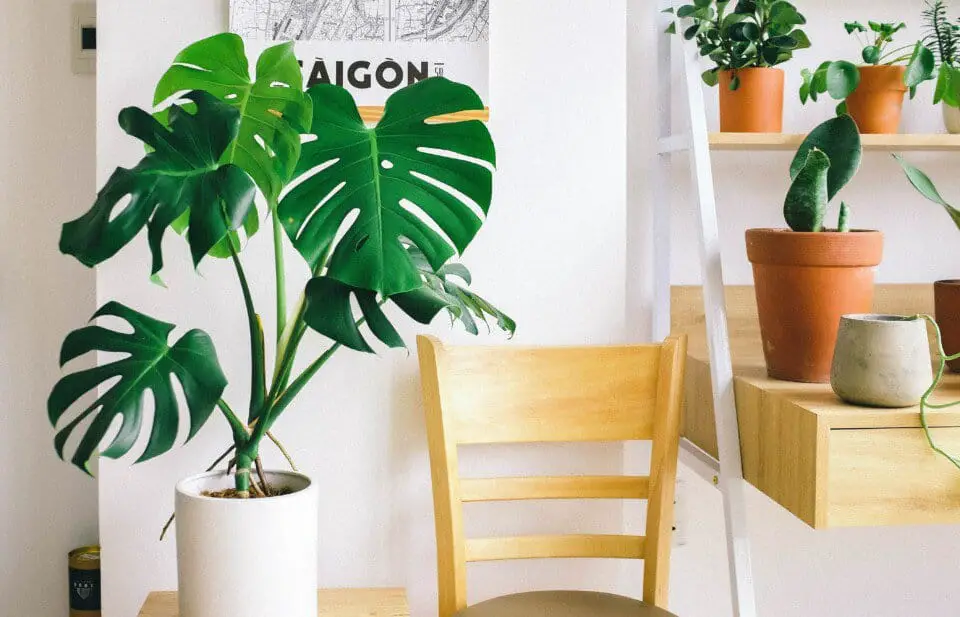Some links in the post are affiliate links and I get a commission from purchases made through some links found in the post.
Monstera deliciosa, the Swiss cheese plant, is a species of flowering plant indigenous to tropical forests of southern Mexico, south of Panama.
Grown in the temperate zones as a house plant, it has several different methods of cultivation. Routinely, the Monstera is grown in hydroponics.
That means they are nourished in a solution containing nutrients and minerals. But why do they have aerial roots? Have you ever wondered? This article will give you all the insights, so let’s catch up!
The aerial roots have two major functions: provide the monstera with nutrients and anchor it. They absorb water which the plant uses for growth and nourishment.
Furthermore, these roots anchor the plant as they ascend to new heights. They grasp the surrounding trees that prevent them from falling and help them climb towards the forest canopy.
Also referred to as prop roots, they provide substantial support to plants as they move up towards the skies to gain sunlight, thus making them essential for plant growth.
That is not it, as we have all the information on aerial roots, from their objective to their maintenance and so on. So without further delays, let’s move on!
What are Aerial Roots?
 First of all, one must know what aerial roots are? They are types of roots that grow from a stem above the ground. They absorb water directly from the air.
First of all, one must know what aerial roots are? They are types of roots that grow from a stem above the ground. They absorb water directly from the air.
Plants usually have roots growing from the basal part of the plants. When roots grow from parts other than the base, they are called adventitious roots, and aerial roots are one such example.
They have three basic purposes: absorb water and dissolved mineral, store food and keep the plant from falling over.
One considerable issue we have with aerial roots is how quickly they dry out, and thus mostly, you’ll see these roots in humid conditions like tropical rainforests.
Some aerial roots even have chlorophyll, so they can serve as food manufacturers in addition to being reservoirs.
Among the types of aerial roots, we have stranglers’ roots, pneumatophores, haustorial roots, and, lastly, propagative roots.
Strangler plants are those in which the aerial roots eventually strangle the plant in which they grow, e.g., Ficus sp. Pneumatophores are aerial roots specialized for gaseous exchange, e.g., roots of mangrove trees.
Haustorial roots are those found in parasitic plants, e.g., roots of mistletoe. Propagative roots develop from the plant nodes, such as those found in strawberry runners and sider plants.
There are many plants with aerial roots. These include epiphytes, orchids, tropical coastal swamp trees, mangroves, and banyan figs.
The warm-temperate rainforest rata, the pohutukawa trees of New Zealand, and Vines such as Common Ivy and poison ivy also have aerial roots.
What is the Difference Between Underground Roots and Aerial Roots?
One often sees unground roots in their vicinities but rarely sees aerial roots as they are mostly found in forests. So what is the difference between the two?
Underground roots germinate from the root tissues of plants having many root hairs.
Root hairs are tiny finger like projections that increase the surface area, thus allowing the plants to absorb considerable quantities of water and minerals.
Furthermore, most of the nutrients sucked up come from the soil. That is, the soil is their main supplier of nourishment. They are tightly embedded in the soil and thus use their support to anchor the plant.
In contrast, aerial roots are above the ground, getting all the nutrients from the air and helping the plants to clasp other surfaces tightly so they can conquer new horizons.
Air is the main water source for such plants; hence they dry out quickly, so extreme care must be taken.
Additionally, aerial roots grow from the stem or leave tissues compared with underground roots that grow from root tissues.
Another predominant distinction is the ability of aerial roots to make their food because they have chlorophyll, while underground roots mainly act as reservoirs only.
Therefore, one can see both are fairly distinct in their attributes.
Why Does my Monstera have Aerial Roots?
The aerial roots have two significant functions: anchor the plant and provide it with appropriate nutrients. Additionally, they can also be used to make food as well as store it.
They not only lay out support but also help the Monstera attach to various plants as it ascends to new heights in search of sunlight and forest canopy.
They hold the plant firmly in its place as it tries to propagate higher and higher.
In the wild, Monstera grows to heights ranging from 30 to 40 feet, and it wouldn’t have been possible without these roots assisting in lending them essential sunlight.
In homes or offices, they need aerial roots to grow up moss poles or totems so that they will mature and display their impressive lacy and holey foliage.
The second foremost role is the provision of nutrients. Yes! These roots play a predominant role in providing plants with all the essential nutrients they need for growth and germination.
They can absorb nutrients from rainwater as it passes over it in addition to taking them from humid air. They also contain tiny pores that help with a gaseous exchange, thus aiding plants inhale carbon dioxide and exhale oxygen.
Ergo, one can see how salient aerial roots are in maintaining adequate growth and for substantial blooming of foliage. Monstera lacking aerial roots more often than not has to face dire consequences, most probably death.
Is It Okay to Cut Aerial Roots off a Monstera?
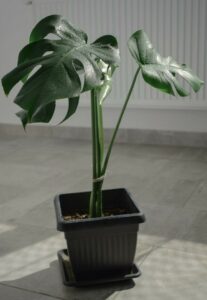
Next up is the answer everyone has been waiting for? Why does my Monstera have aerial roots? What can be the associated complication? Everything you need to know is near at hand!
For various reasons, Gardeners often have been fascinated by the proposition of cutting down aerial roots of their Monstera. We will tell you in detail whether it is feasible? What are the drawbacks? And much more!
More often than not, Gardeners have wanted to cut down the aerial roots because they consider it an eyesore compared with the Monstera’s lush green leaves.
There is no real reason to cut down these roots, as even when they are pinned against the wall, they won’t damage your wall.
On top of that, these roots can be buried in the soil to provide additional nutrients to your plant or be tied up.
But people who are especially conscious about aesthetics can find them relatively irritating and hence like them to be removed.
The good news for them is that removing them is no harm, and they can easily be hacked down according to our ease. Usually, a 30% cut down is recommended to avoid stressing the plant.
When cutting these adventitious roots, use sharp, sterilized pruning shears. 70 to 90% rubbing alcohol is perfect for disinfecting your gardening tools. You don’t want to transmit diseases to your plants.
Although chopping down roots has no significant effect, some people have noticed a slight decrease in growth rate without aerial roots, so it is desirable to trim these roots rather than cutting them off altogether.
In case of root rot, chopping them down becomes a necessity.
How do you Water Aerial Roots on a Monstera?
Water is an essential ingredient for the proper blooming of your Monstera, and aerial roots often dry out quickly.
The reason is them being in close proximity to air, so most of the water volatilizes from their surface. Under such conditions, one must know all the technicalities about watering your plant.
Though some sources recommend placing aerial roots directly in water, placing them in them for too long would rot the roots endangering your plant.
Frequently, bacteria start to house in such water, causing the roots to decompose. Another problem is plants not getting the adequate oxygen they need for growth.
Moreover, the plant may begin to depend on aerial roots instead of the true root network for water, thus, hampering their propagation. The solution is to spray them with water instead of submerging them in it.
A light misting a couple of times per week or slightly more often in dry weather will keep the roots from drying out, supplement the water the plant gets from its roots, and help it to absorb any nutrients that are available if the roots are in contact with a moss pole.
The jet should be focused on the aerial roots, helping them soak moisture as well as increasing the general humidity level, which is very good for your Monstera. Lack of water makes these aerial roots shrivel and become brittle.
Should I Bury Aerial Roots?
Gardeners have often considered burying these aerial roots on various grounds, from aesthetical issues to their ability to accelerate growth. It is thoroughly safe to bury these roots in the soil.
Rather in some cases, it is highly recommended to bury these roots so that Monstera can get nutrients at a brisk rate. While in soil, they will absorb nutrients, gradually increasing the growth of your Monstera.
Aerial roots are designed to be in the air, but if you have a young one, i.e., one that hasn’t gone woody and brown yet, you can convince it to become an underground root.
Though they can increase the rate of germination, one should avoid putting them in the soil as they can’t support the plant, their principal purpose.
Additionally, they may rot, something you want to keep at arm’s length. A simple solution to this is to place your plant in a larger pot to avoid the danger of them rotting due to excess moisture.
Strictly speaking, one can put aerial roots in the soil, but it is superior to leave them as they are for better yields.
How do you Train Aerial Roots Monstera?
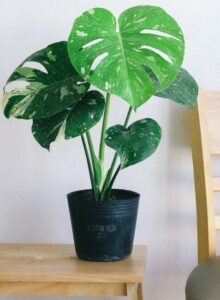 Next up, we will tell you how to train your Monstera to outstretch to new horizons. First of all, you need a support structure on which your Monstera can climb.
Next up, we will tell you how to train your Monstera to outstretch to new horizons. First of all, you need a support structure on which your Monstera can climb.
A moss pole, coco coir pole, multiple baboon canes, U-shaped cane support, or trellis can encourage your Monstera to grow upright.
The trick is following the plant’s natural inclination for climbing, which can help them grow larger leaves. Naturally, Monstera can climb using various surfaces as a support medium.
The younger plant usually grows vertically upwards but tends to grow sideways as they get older and heavier. Pruning your plant will prevent it from developing leaves and stem in any direction but up.
This serves the dual purpose of training the plant to grow in a vertical direction and keeping it within a manageable size. The right time to add a pole is when your Monstera shows more horizontally than vertically.
Consequently, waiting too long before adding a pole makes it strenuous to train your Monstera to grow in your desired direction.
How do you Repot a Monstera with Aerial Roots?
Repotting can often become an arduous task, but fortunately, we have all the particulars for easy repotting of your Monstera.
There is no hard and fast rule when repotting your Monstera.
If the aerial roots are near the bottom of the plant, place them in the soil so they’ll provide nutrients, but if they are a bit higher up, you can cut them up without having deleterious effects on your plant. The method is as follows:
- Choose a 1-2 inch larger pot to prevent the roots from waterlogging in the new pot.
- Fill the pot with soil till halfway. You will need an airy organic potting mix.
- Tip your Monstera on one side and slide the plant from the pot. Use one hand to hold the pot and the other to guide the plant.
- Use fresh soil and inspect the root before replanting. Healthy roots are flexible and light tan. Trim brittle and discolored roots before replanting.
- Put your Monstera in the new pot and spread soil over it, allowing it to grow freely.
- Adjust your Monstera so that the crown of the plant meets the soil level
- Backfill the pot with fresh soil and firm it down with your hands to secure it.
How do you Help your Aerial Roots to Grow?
Germination has never been plain sailing, and growing aerial roots is no different. One must provide them with proper ambiance for them to bloom considerably. Let’s take a look at some of the ways to enhance root growth.
Provide your Monstera with lots of bright indirect sunlight through a window or a grow light that works for at least 8 hours a day.
Direct sunlight must be avoided. In addition, Pot your Monstera in a pot with drainage holes and a peaty potting mix that drains well.
Furthermore, Water your Monstera when the top 2-3 inches feel dry or when or when the meter reads 3-4.
Using a meter is highly recommended as it gives an idea of the entire soil and not just the one at the top. Moving on, you will need to bestow your plant with appropriate nutrients for a healthy blooming of roots.
Liquid fertilizer with a 5-2-3 NPK value is recommended to provide your Monstera with an ideal nutrient balance.
We suggest using the Monstera plant food as it was essentially created for this purpose. Thus under the circumstances mentioned above, one can grow the best quality aerial roots for their Monsteras.
Can New Roots Grow from Aerial Roots?
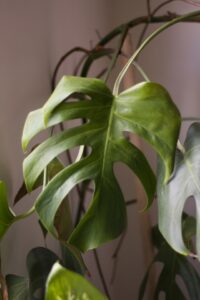 Yes! One can propagate new roots from existing ones. Quite often, roots emerge from existing roots, making them an effective absorber of nutrients.
Yes! One can propagate new roots from existing ones. Quite often, roots emerge from existing roots, making them an effective absorber of nutrients.
It is very common for an aerial root to have many branches to increase its surface area, making it an effective supporter.
It can hold on to different surfaces using its thick network of branches as well as provide efficient nourishment to the plant.
Though new roots can grow from existing ones, a new plant cannot produce roots as it requires a stem with at least one node and a few leaves for its propagation.
Therefore, Aerial roots, though they can be used to grow new roots, cannot be used to sprout new plants as they require at least a few leaves for the all-important process of photosynthesis.
Therefore Monstera can also be propagated from stem cuttings rather than root cuttings.
Why does my Monstera have so Many Aerial Roots?
Aerial roots have many distinct functions in the maintenance of your Monstera, and more than often, one sees them in abundance around their plants. Is this a cause of concern?
Should one worry if its Monstera produces far too many aerial roots? Well, one need not worry if they see their plants growing aerial roots in abundance as these roots serve as nourishers and support systems for your plant.
The more the number of aerial roots Monstera has, the more steadily it can absorb nutrients from its surroundings.
With a large number of aerial roots, the rate at which nutrients reach the growing parts of the plant increase by several folds, thus ensuring that your plant is getting adequate minerals to bloom.
Furthermore, they are used as support, so, with a dense system of aerial roots, Monstera can climb onto surfaces faster and hold firmly to them without tipping over.
Many aerial roots are not a cause for concern and do not signal that your Monstera plant is unhealthy.
Still, If you find them unsightly, go ahead and prune them off the vine. Don’t go off cutting all the roots. Consider bountiful aerial roots a sign your Monstera plant is healthy and growing as it should. Fascinating right?
Why is my Monstera Growing Aerial Roots But No Leaves?
A houseplant owner is often bothered when their Monstera is growing excessive roots but not leaves. This is a worrying symptom as it indicates that the plant is not getting adequate nutrients.
We have discussed above in detail how aerial roots have a predominant role in providing the plants with nutrients, minerals, and sufficient water.
Unavailability of any of these will cause the roots to grow to greater distances in search of water, hampering the growth of leaves. This will cause your Monstera to have a greater quantity of roots than it has leaves on it.
What is the solution? Well, the solution is quite a simple one. You should provide the Monstera plant with enough minerals, nutrients, and water, and you will see your Monstera transform.
With an adequate supply of supplements, the energy produced will be used in propagating new leaves instead of roots, and thus your plant will show lush green foliage with a lesser quantity of roots.
Other measures used to encourage leaf growth include repotting the plant, feeding the plant with slow-release fertilizer, trimming the aerial roots, and Moving to a position that gets filtered light quantity.
Final Thoughts
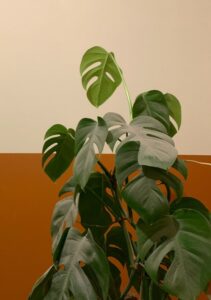 Aerial roots are an integral part of a Monstera as they provide support and nourishment to the houseplant. They help the plant reach new heights while maintaining support.
Aerial roots are an integral part of a Monstera as they provide support and nourishment to the houseplant. They help the plant reach new heights while maintaining support.
Aerial roots grow from the upper part of the stem and cannot be used as an alternative to underground roots.
It has several distinct characteristics that make it unique and essential for the healthy growth of your houseplant.
Another predominant distinction is the ability of aerial roots to make their food because they have chlorophyll, while underground roots mainly act as reservoirs only.
Aerial roots usually dry out very quickly and thus must be kept in a moist environment.
Though your plant can survive without aerial roots, it will hamper growth, so they must not be chopped down and should only be sprayed with water to ensure that they don’t get any bacterial or fungal infections.
Moving forward, we can train our Monstera to grow straight up using supports and can also repot the house plant following a simple procedure.
Adequate conditions should be provided to ensure efficient root growth, with plants having large quantities of roots a sign of lack of nutrients. Henceforth, one can judge the importance of aerial roots to a houseplant.
About the Author:
Saad Ansar
Saad is an avid gardener himself and is a great lover of plants, animals, photography, & people. Currently, he is focused on photographing indoor plants & captioning beautiful outdoor sceneries. He writes and rewrites in-depth articles on nature and science.

